Basmati Rice Farming
When analyzing basmati rice farming profit per acre, manual planting yields a total income of NRs. 100,000 (2,000 kg at NRs. 50/kg) against production costs of NRs. 52,700, resulting in a net profit of NRs. 47,300 and a 47.3% profit margin. In contrast, the rice transplanter method generates NRs. 125,000 (2,500 kg at NRs. 50/kg) with reduced costs of NRs. 51,500 due to lower seed and labor expenses, achieving a higher net profit of NRs. 73,500 and a 58.8% margin.
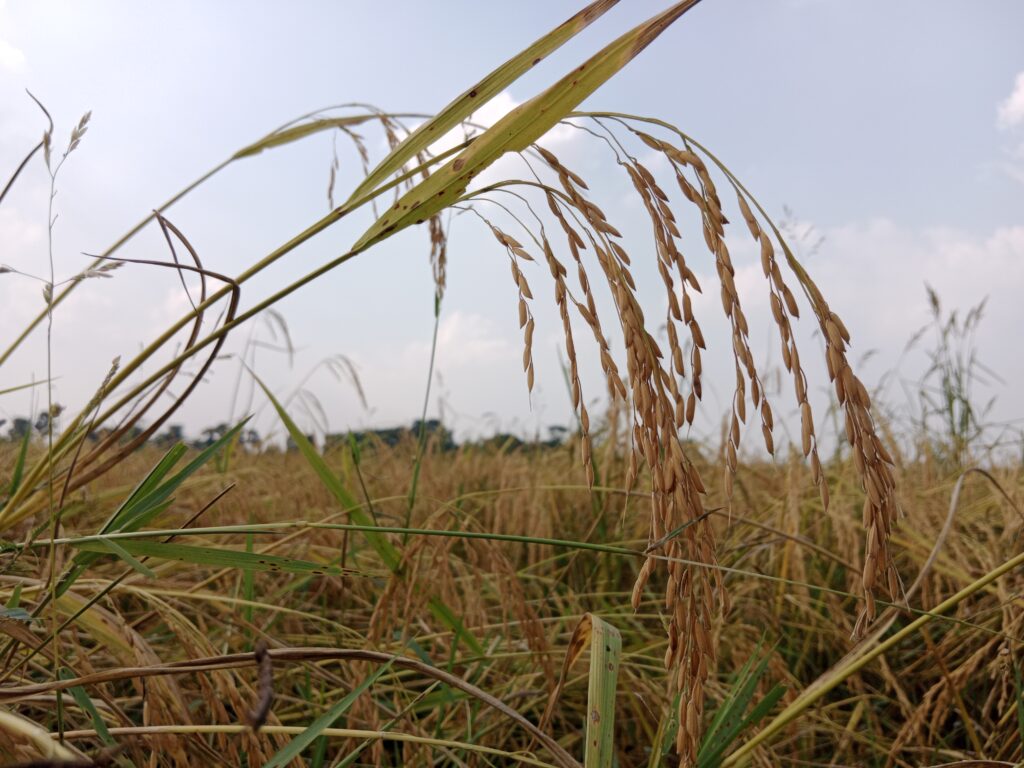
The transplanter’s NRs. 26,200 profit advantage per acre stems from its 25% greater yield, offsetting slightly higher weed control costs, while its scalability and efficiency make it ideal for large-scale cultivation. Farmers are thus recommended to adopt rice transplanters to optimize Basmati rice farming profit per acre through enhanced profitability and resource efficiency.”
Land Preparation
Land preparation for Basmati rice cultivation is a meticulous process that begins with deep plowing at 20-25 cm to aerate the soil, enhance its structure, and promote root penetration. This is followed by harrowing and leveling to break down clods, incorporate organic matter, and create a smooth, puddled surface, which is essential for optimal growth conditions. Puddling, the practice of churning saturated soil into a soft, muddy consistency, plays a dual role by improving water retention and suppressing weed growth, critical in maintaining soil moisture and reducing competition for nutrients.
To ensure efficient water management, fields are subdivided into smaller plots of 1-2 acres, surrounded by raised earthen bunds that help regulate irrigation, prevent water runoff, and maintain uniform water distribution. Together, these steps establish a well-prepared, controlled environment that supports the high water and nutrient demands of Basmati rice, fostering healthy crop establishment and maximizing yield potential.
Soil Type
Basmati rice cultivation thrives in loamy to clayey soils, which provide excellent water retention essential for meeting the crop’s high moisture needs during its growth stages. The ideal soil pH range of 6.0–7.5 ensures nutrient availability and supports root health. Proper drainage is crucial to prevent waterlogging, root diseases, and to maintain soil aeration, promoting healthy root development.
In contrast, highly saline, sodic, or waterlogged soils are unsuitable as they impair root function and nutrient absorption. However, such soils can be improved with amendments like gypsum to reduce salinity or sodicity and organic matter to enhance structure and drainage. By selecting suitable soils and addressing pH and drainage requirements, farmers can establish optimal conditions for successful Basmati rice cultivation.
Climatic Requirements
Basmati rice cultivation demands specific climatic conditions, requiring warm temperatures between 20–38°C, with higher daytime temperatures promoting vigorous vegetative growth and cooler nights (particularly during the grain-filling stage) to enhance the development of its characteristic aroma and quality.
Adequate moisture is essential, either through well-distributed rainfall of 1200–2000 mm annually or supplemental irrigation, to sustain the crop’s long growing season of 110–150 days, which varies depending on the variety. Additionally, moderate humidity during critical phases like flowering and grain filling is crucial to prevent stress, ensure proper pollination, and maximize yield potential.
These interconnected climatic factors—temperature fluctuations, consistent water availability, seasonal duration, and humidity control—collectively influence the crop’s productivity, aromatic quality, and overall adaptability to regional growing conditions.
Major basmati rice varieties
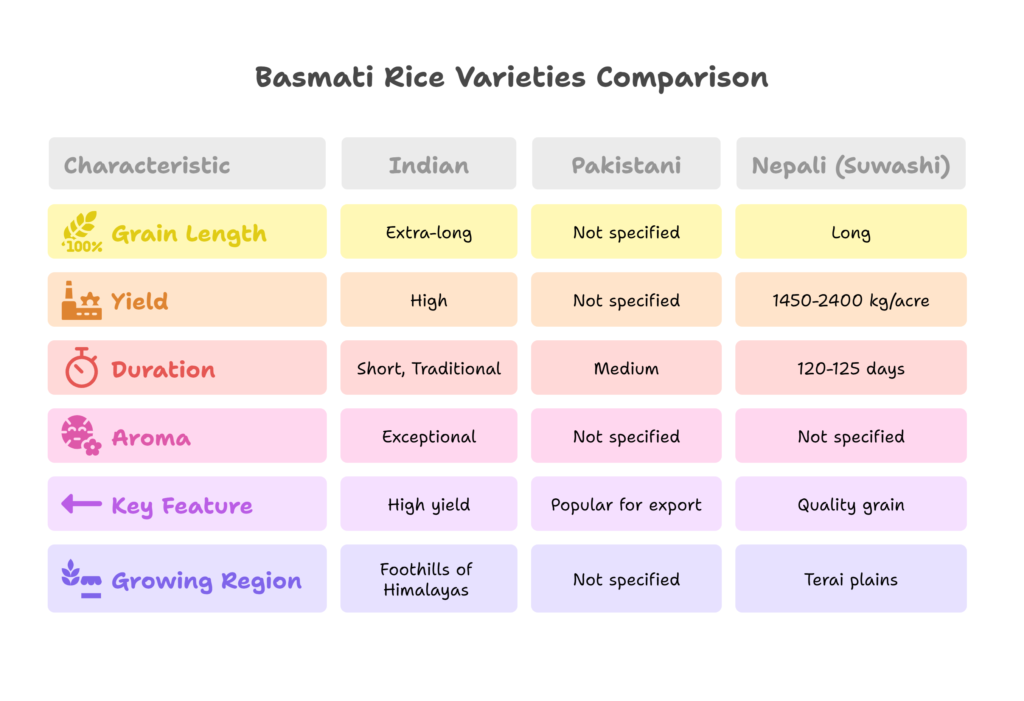
a). Indian Varieties
- Pusa Basmati-1121: Known for extra-long grains and high yield.
- Pusa Basmati-1509: Short-duration variety.
- Taraori Basmati (HBC-19): Traditional variety with exceptional aroma.
- Basmati-370: Grown in the foothills of the Himalayas.
b). Pakistani Varieties
- Super Basmati: Popular for export.
- Shaheen Basmati: Medium-duration variety with good grain quality.
c). Nepali Varieties
- Suwashi
One of the most popular Nepali Basmati varieties is Suwashi, which has long grains and a 120–125 day growth cycle. It is planted mostly in the warm, humid Terai plains of Nepal. It may be grown in both the chaite (spring, February–June) and barkhe (main, June–October) seasons, yielding between 1450 and 2400 kg per acre. A major problem, though, is that it is susceptible to Bakanae disease, which is brought on by the fungus Fusarium fujikuroi and results in aberrant elongation and stunting of seedlings, ultimately lowering yields. This disease is particularly common during the spring (chaite) cultivation season.
More about Bakanae disease: Bakanae disease management
Seed Selection
For successful basmati rice cultivation, begin by selecting certified seeds of recommended high-yielding varieties to ensure genetic purity and productivity. Prioritize seeds that are free from inert matter, pests, and diseases, and exhibit uniformity in size and color, as these traits contribute to consistent germination and healthy crop establishment. Additionally, conduct a germination test before planting to verify a germination rate exceeding 85%, which is critical for achieving optimal field emergence and maximizing yield potential. Proper seed quality management at this stage lays the foundation for a robust and uniform crop.
Seed rate per Acre

a). Manual Planting
Basmati rice requires a higher seed rate of 20–25 kg per acre in manual planting due to the broadcast sowing method and lower seedling survival rates.
b). Rice Transplanter
For mechanical transplanting of fine Basmati rice, a reduced seed rate of 8–12 kg per acre is recommended, as efficient spacing minimizes waste.
Nursery Establishment
a). Manual planting
For manual planting of Basmati rice, prepare a nursery bed equivalent to 1/10th the area of the main field. Soak the seeds in water for 48 hours, then transfer the seeds to a shaded environment for several days to encourage germination, and once sprouted, sow the seeds at a density of 1 kilogram per 40 square meters (1 kg/40 m²). And maintain a consistent water depth of 2–3 cm to ensure optimal germination; seedlings typically become ready for transplanting into the main field within 25–30 days under these conditions.
b). Rice transplanter
For mechanized rice transplanting, utilize tray nurseries with 90–110 trays per acre, sowing 90 g of seeds per nursery tray. This practice enhances grain yield by boosting productive tillers and grain weight, making this method ideal for achieving higher productivity and economic returns in mechanized cultivation systems. As the seedlings becoming ready for transplanting within 18–22 days, enabling efficient field establishment and faster crop turnaround.
Planting
a). Manual Planting
For manual planting of Basmati rice, transplant 20–25-day-old seedlings at a spacing of 20 cm between rows and 15 cm between hills, placing 2–3 seedlings per hill to balance plant density and minimize competition, while maintaining a consistent water depth of 3–5 cm to support root establishment, reduce weed growth, and ensure optimal tillering and nutrient uptake during early growth stages.
b). Rice Transplanter
Machine The rice transplanter effectively plants 18–22-day-old seedlings at a consistent 20×20 cm spacing for mechanical rice transplantation, guaranteeing even plant distribution and less competition for resources including light, nutrients, and water. In addition to improving field efficiency and lowering labor expenses, this exact spacing improves tillering, root growth, and overall crop uniformity, increasing yield by 10% to 15% when compared to conventional methods.
Irrigation
Optimal water management is critical to maintain yield and quality. During early growth stages (germination to tillering), maintain standing water at 1–2 cm to support seedling establishment, increasing to 3–5 cm during reproductive stages (panicle initiation to flowering) to meet higher moisture demands. To conserve water, employ techniques like Alternate Wetting and Drying (AWD) after the tillering phase, allowing the soil to dry until surface cracks appear before re-irrigating, reducing water use by 25–30% without compromising yield. Avoid waterlogging, particularly during maturity, as stagnant water promotes lodging (stem bending) and diseases like root rot. Ensure proper drainage systems to prevent oversaturation, balancing soil moisture to sustain grain filling while preserving plant health.
Fertilizer and Manure
a). Basal Application
Basal application in Basmati rice cultivation involves incorporating 50% of the total recommended nitrogen (N) dose, along with the full requirement of phosphorus (P₂O₅) and potassium (K₂O), into the soil prior to transplanting.
This ensures essential nutrients are readily available during the critical early growth stages, with phosphorus promoting robust root development and energy transfer, potassium enhancing stress tolerance and water regulation, and the partial nitrogen dose supporting initial vegetative growth. By pre-mixing these nutrients into the puddled soil, the practice establishes a balanced nutrient base, reduces leaching losses, and primes seedlings for vigorous establishment, ultimately contributing to higher tillering, improved nutrient uptake efficiency, and optimized yield potential.
b). Top Dressing
For top dressing in Basmati rice cultivation, the remaining 50% of nitrogen (N) is applied in two split doses: the first during the active tillering stage (25–30 days after transplanting) to boost vegetative growth and tiller formation, and the second at the panicle initiation stage (50–60 days after transplanting) to support grain development and panicle elongation. This split application optimizes nitrogen use efficiency by aligning nutrient availability with critical growth phases, minimizes losses due to leaching or volatilization, and ensures balanced vegetative-reproductive growth, enhancing both yield and the aromatic quality of the grains.
c). Organic Manures
In Basmati rice cultivation, the application of organic manures such as farmyard manure (FYM) or compost at a rate of 10–15 tons per hectare serves as a cornerstone for enhancing soil health and sustainability. These organic inputs enrich the soil with essential macro- and micronutrients, including nitrogen, phosphorus, potassium, and organic carbon, while improving soil structure by promoting aggregation, which enhances aeration, water infiltration, and moisture retention.
The slow-release nature of organic manures ensures prolonged nutrient availability, supporting microbial activity and fostering long-term soil fertility without the risk of nutrient leaching or salinity buildup. Additionally, they counteract soil degradation by replenishing organic matter, reducing dependency on synthetic fertilizers, and improving the soil’s cation exchange capacity (CEC), which enhances nutrient-holding efficiency. Incorporating organic manures aligns with sustainable agricultural practices, promoting resilient crop growth, higher yields, and improved grain quality in Basmati rice systems, while maintaining ecological balance.
Weed Control
a). Manual Weeding
In Basmati rice cultivation, manual weeding is conducted twice to manage weed competition: first at 20–25 days after transplanting to remove early-emerging weeds and again 40–45 days later to address subsequent weed growth. This labor-intensive practice ensures minimal competition for nutrients, water, and sunlight during critical growth stages, preventing yield losses while avoiding herbicide use in sensitive or small-scale fields. Hand weeding also aerates the soil, disrupts weed life cycles, and supports healthier root development, aligning with traditional or organic farming practices.
b). Chemical Control
In Basmati rice cultivation, chemical weed control involves applying pre-emergence herbicides like butachlor (at 0.5–1.0 kg a.i./acre) within 3 days of transplanting to suppress early weed germination, followed by post-emergence herbicides such as bispyribac-sodium, if persistent weeds emerge, targeting grasses and broadleaf species while minimizing crop damage. This sequential approach ensures effective weed suppression, reduces competition for nutrients and water, and enhances yield potential, provided herbicide dosages and application timings align with crop stages and local guidelines to avoid phytotoxicity or resistance development.
Pest and Disease Management
Common Pests
a). Rice stem borer
The rice stem borer (Scirpophaga incertulas) is a major pest in Basmati rice cultivation, with larvae tunneling into stems during tillering and flowering stages, causing “dead hearts” (dried tillers) and “white heads” (empty panicles), leading to significant yield losses. Management involves integrated strategies such as removing crop residues to disrupt overwintering pupae, deploying pheromone traps for adult monitoring, releasing egg parasitoids like Trichogramma wasps, and timely application of insecticides such as chlorantraniliprole or cartap hydrochloride during peak larval hatching. Regular field scouting and early intervention are critical to minimize damage and maintain crop health.
b). Rice leaf folder
The rice leaf folder (Cnaphalocrocis medinalis), a major pest in Basmati rice, damages crops as larvae fold and feed inside leaves, creating white streaks and skeletonized tissue that reduce photosynthesis and grain yield. Management involves cultural practices like removing weeds to disrupt breeding, biological control through natural predators (e.g., spiders, Trichogramma wasps), and targeted insecticide application (e.g., chlorantraniliprole, emamectin benzoate) during early infestation. Timely intervention, guided by field scouting to detect leaf damage thresholds, minimizes yield loss while supporting sustainable integrated pest management strategies.
c). Brown plant hopper
The brown plant hopper (Nilaparvata lugens), a major pest in Basmati rice, feeds on sap from stems and leaves, causing “hopper burn” (yellowing, wilting, and collapse of plants) and transmitting viral diseases like grassy stunt. Outbreaks are often linked to excessive nitrogen use and waterlogged conditions. Management includes resistant varieties (e.g., IR64, BPH-resistant Basmati lines), balanced fertilization, controlled irrigation, biological controls (e.g., Cyrtorhinus bugs, spiders), and judicious insecticide application (imidacloprid, buprofezin) during early infestations. Regular monitoring and avoiding insecticide overuse prevent resistance and preserve natural predators.
d). Rice Bug
The rice bug (Leptocorisa spp.), a key pest in Basmati rice, damages developing grains by piercing and sucking sap during the flowering and milky stages, leading to discolored, shriveled “pecky rice” and reduced market quality. Management includes cultural practices like synchronous planting to avoid peak pest activity, maintaining field hygiene to remove alternate hosts, deploying light traps for adults, and encouraging natural predators (e.g., spiders, Ophionea beetles). Targeted insecticide sprays (lambda-cyhalothrin, thiamethoxam) are applied at panicle emergence if infestations exceed thresholds, ensuring minimal disruption to beneficial insects and residue-free grains for premium market standards.
Common diseases
a). Bakanae disease
Bakanae disease, caused by the fungal pathogen Fusarium fujikuroi, affects Basmati rice through infected seeds or soil, leading to elongated, pale seedlings (“bakanae” or “foolish seedlings”), stunted growth, and sterility. Management involves seed treatment with fungicides (e.g., carbendazim at 2g/kg seed) or hot water (52–54°C for 10–12 minutes), using certified disease-free seeds, crop rotation, and avoiding excessive nitrogen and waterlogging. Resistant varieties (e.g., Pusa Basmati 1121, 1509) and field sanitation to remove infected plants are critical to curb spread, ensuring healthy crop establishment and minimizing yield and quality losses.
b). Blast
Rice blast, caused by the fungal pathogen Magnaporthe oryzae, manifests as diamond-shaped lesions on leaves, nodes, and panicles, leading to lodging, panicle sterility, and yield loss in Basmati rice. Management includes resistant varieties (e.g., Pusa Basmati 1637, 1728), avoiding excessive nitrogen, ensuring field drainage, and wide spacing (20×20 cm) to reduce humidity.
Fungicides like tricyclazole (0.1%) or azoxystrobin are applied at early symptom detection, while field sanitation—removing crop residues and alternate hosts—curbs spore spread. Integrated approaches combining resistant genetics, balanced nutrition, and timely fungicide use mitigate outbreaks, preserving grain quality and yield in high-value Basmati systems.
c). Bacterial leaf Blight (BLB)
Bacterial leaf blight (BLB), caused by Xanthomonas oryzae pv. oryzae, affects Basmati rice through water-soaked lesions that turn yellow and necrotic, leading to reduced photosynthesis and grain yield. Management includes resistant varieties (e.g., PB1, Pusa Basmati 1718), seed treatment with streptomycin (0.01%) or hot water (50–52°C), avoiding excessive nitrogen and water stagnation, and ensuring field drainage to limit bacterial spread.
Copper-based bactericides (e.g., copper oxychloride) or bioagents (Pseudomonas fluorescens) are applied during early infection, while removing infected residues and practicing crop rotation disrupt pathogen survival. Timely interventions minimize yield loss and maintain the premium quality of Basmati grains.
Harvesting
Basmati rice is optimally harvested when grains attain a golden-yellow hue and reach a moisture content of 20–22%. Small-scale farmers typically use sickles for manual cutting, while combine harvesters streamline large-scale operations. Post-harvest, grains are sun-dried to reduce moisture to 12–14%, a critical step to safeguard against fungal growth and spoilage during storage. Finally, the dried grains are stored in airtight containers or bins to maintain their aromatic quality, texture, and market value, ensuring long-term preservation and protection from pests and humidity.
Yield of Basmati Rice per Acre
The yield of Basmati rice depends on farming practices, soil fertility, climate, and variety. Here’s a general comparison:
a). Manual Planting (Traditional Transplanting)
Average yield ranges from 18–22 quintals (1,800–2,200 kg) per acre under optimal conditions. Manual transplanting ensures better spacing and plant density, but labor costs and inconsistencies in seedling placement can limit yield potential.
b). Mechanical Planting (Rice Transplanter)
Mechanical transplanting achieves 20–25 quintals (2,000–2,500 kg) per acre due to uniform spacing, reduced seedling stress, and efficient use of young seedlings (15–20 days old). Hybrid Basmati varieties (e.g., Pusa Basmati 1121) under mechanized systems may even reach 25–30 quintals/acre with precision irrigation and nutrient management.
Cost of Investment per Acre for Basmati Rice Farming
(Values in Nepalese Rupees, NRs)
| S.N. | Categories | Manual Planting | Rice Transplanter |
| 1 | Land Preparation (plowing, puddling) | 15,000 | 15,000 |
| 2 | Seed rate per acre | 2,000 | 1,000 |
| 3 | Labor Costs (Planting) | 7,200 | 6,000 |
| 4 | Fertilizers and Manure | 6,000 | 6,000 |
| 5 | Irrigation | 5,000 | 5,000 |
| 6 | Weed Control (pre & post-emergence) | 4,000 | 5,000 |
| 7 | Pest & Disease Control | 6,500 | 6,500 |
| 8 | Miscellaneous Costs | 7,000 | 7,000 |
| Total Cost | 52,700 | 51,500 |
Income from one Acre Basmati rice farming
| Method | Estimated Yield | Market Price (NRs/kg) | Total Income (NRs.) |
| Manual Planting | 2,000 kg | 50 | 100,000 |
| Rice Transplanter | 2,500 kg | 50 | 125,000 |
Analysis of Basmati (Suwashi) Rice Farming Profit Per Acre
a). Manual Planting
For Basmati rice farming using manual planting, the total income generated per acre is NRs. 100,000 based on an estimated yield of 2,000 kg sold at a market price of NRs. 50 per kg. After accounting for the total production cost of NRs. 52,700 (covering land preparation, seeds, labor, fertilizers, irrigation, weed and pest control, and miscellaneous expenses), the net profit amounts to NRs. 47,300. This results in a profit margin of 47.3%, calculated as (Profit/Total Income) × 100, reflecting the cost efficiency and revenue potential of manual planting despite its relatively low yield compared to mechanized alternatives.
b). Rice Transplanter
For Basmati rice farming using the rice transplanter method, the total income per acre is NRs. 125,000, derived from an estimated yield of 2,500 kg sold at NRs. 50 per kg. After deducting the total production cost of NRs. 51,500 (covering land preparation, reduced seed and labor expenses, fertilizers, irrigation, weed/pest control, and miscellaneous costs), the net profit amounts to NRs. 73,500. This results in a profit margin of 58.8%, calculated as (Profit/Total Income) × 100, highlighting the method’s superior efficiency and profitability due to higher yields and optimized resource use compared to manual planting.
Recommendation
The rice transplanter method generates NRs. 26,200 more profit per acre compared to manual planting, driven by a higher yield of 2,500 kg (vs. 2,000 kg for manual methods), which compensates for slightly elevated weed control costs. Enhanced cost efficiency is achieved through reduced seed usage (NRs. 1,000 vs. NRs. 2,000) and lower labor expenses (NRs. 6,000 vs. NRs. 7,200), contributing to a total profit of NRs. 73,500 and a 58.8% profit margin for the transplanter method, significantly outperforming manual planting’s 47.3%. This stark margin difference underscores the transplanter’s scalability and operational efficiency, making it a recommended choice for farmers, particularly in large-scale Basmati rice cultivation, to maximize profitability and resource optimization.
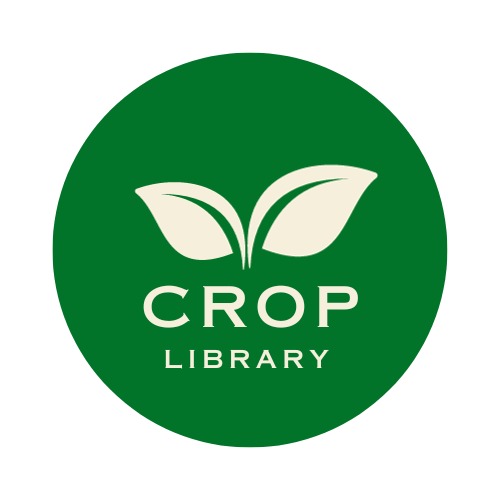
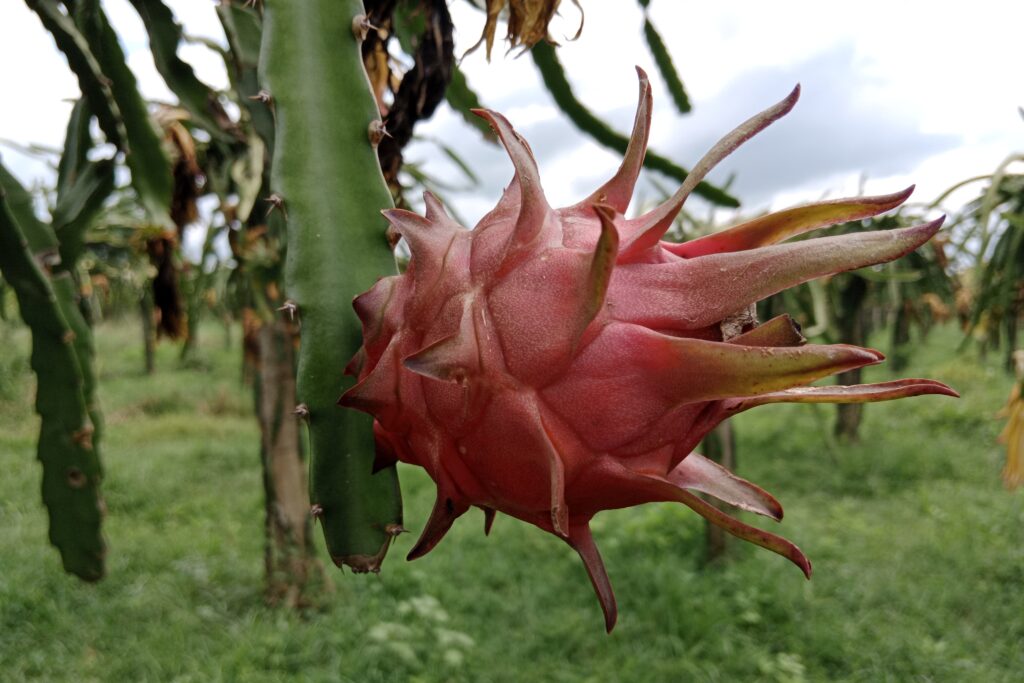
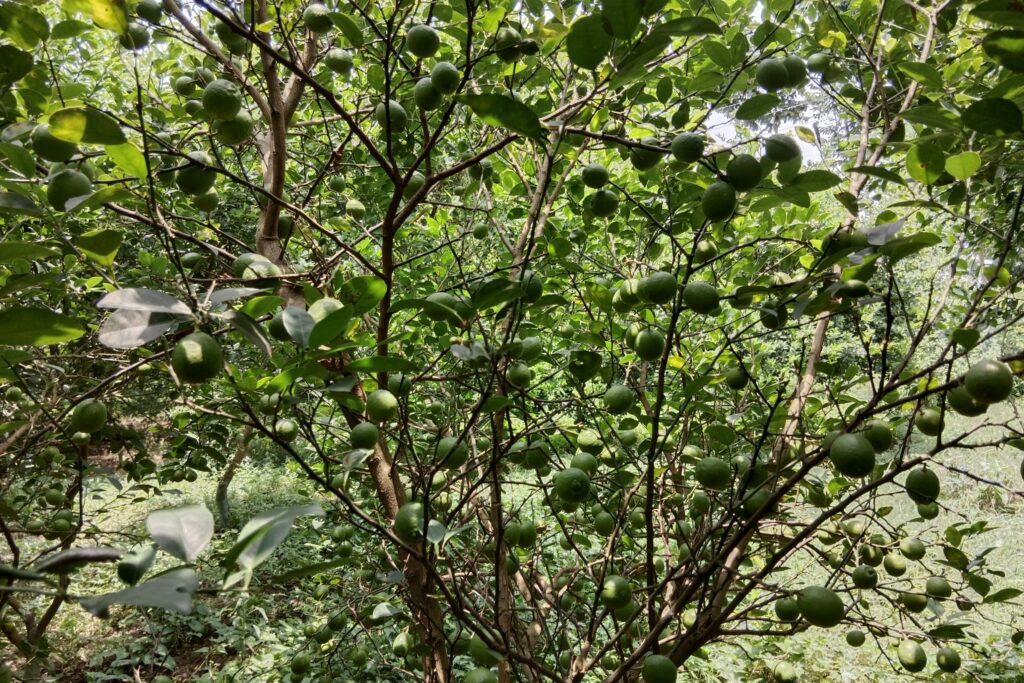
Pingback: Basmati Rice – White Gold of Agriculture For Farmers